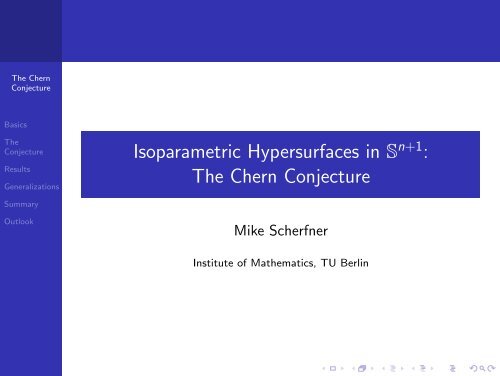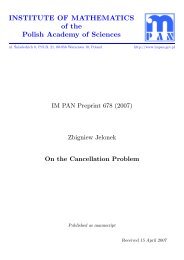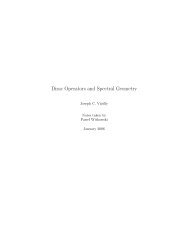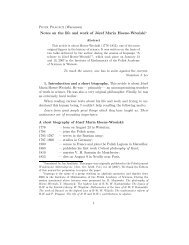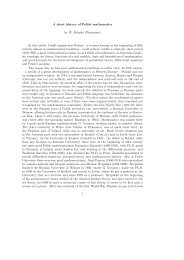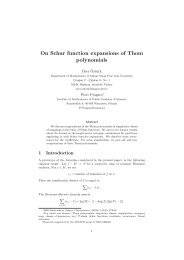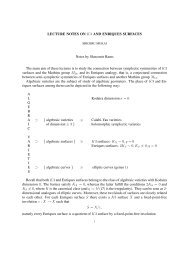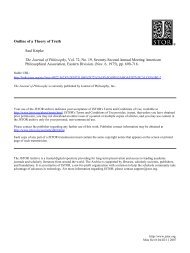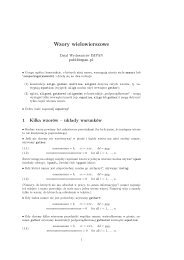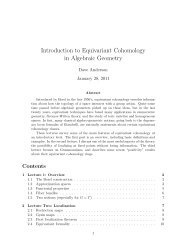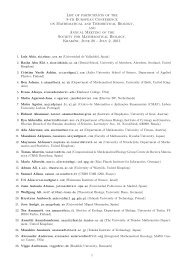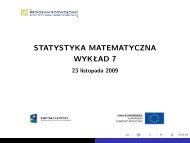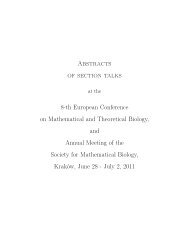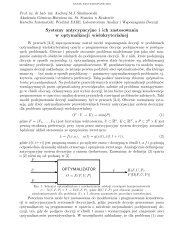Isoparametric Hypersurfaces in Sn+1: The Chern Conjecture
Isoparametric Hypersurfaces in Sn+1: The Chern Conjecture
Isoparametric Hypersurfaces in Sn+1: The Chern Conjecture
- No tags were found...
Create successful ePaper yourself
Turn your PDF publications into a flip-book with our unique Google optimized e-Paper software.
<strong>The</strong> <strong>Chern</strong><strong>Conjecture</strong>Basics<strong>The</strong><strong>Conjecture</strong>ResultsGeneralizations<strong>Isoparametric</strong> <strong>Hypersurfaces</strong> <strong>in</strong> S n+1 :<strong>The</strong> <strong>Chern</strong> <strong>Conjecture</strong>SummaryOutlookMike ScherfnerInstitute of Mathematics, TU Berl<strong>in</strong>
<strong>The</strong> <strong>Chern</strong><strong>Conjecture</strong>Basics<strong>The</strong><strong>Conjecture</strong>ResultsGeneralizationsSummaryOutlook1 Basics2 <strong>The</strong> <strong>Conjecture</strong>3 Results4 Generalizations5 Summary6 Outlook
Content<strong>The</strong> <strong>Chern</strong><strong>Conjecture</strong>Basics<strong>The</strong><strong>Conjecture</strong>ResultsGeneralizationsSummaryOutlookWe present a short history of the <strong>Chern</strong> conjecture forisoparametric hypersurfaces <strong>in</strong> spheres and generalizations.Ma<strong>in</strong> results will be presented and we summarize the progressfor this topic.
<strong>The</strong> <strong>Chern</strong><strong>Conjecture</strong>Basics<strong>The</strong><strong>Conjecture</strong>ResultsGeneralizationsSummaryOutlook
Basics<strong>The</strong> <strong>Chern</strong><strong>Conjecture</strong>Basics<strong>The</strong><strong>Conjecture</strong>ResultsGeneralizationsSummaryOutlookWe are concerned with hypersurfaces, i. e. n-dimensionalsubmanifolds <strong>in</strong> (n + 1)-dimensional Riemannian manifolds.<strong>The</strong> curvature of a hypersurface M <strong>in</strong> the ambient manifold isdescribed by the second fundamental form h (or the associatedshape operator A). <strong>The</strong> eigenvalues of h are the pr<strong>in</strong>cipalcurvature functions λ i , i = 1...n.
<strong>The</strong> <strong>Chern</strong><strong>Conjecture</strong>Basics<strong>The</strong><strong>Conjecture</strong>ResultsGeneralizationsSummaryOutlookA hypersurface <strong>in</strong> a space of constant curvature c is calledisoparametric, if all the λ i are constant functions.In R n+1 all the isoparametric hypersurfaces are hyperspheres,hyperplanes or (generalized) cyl<strong>in</strong>ders S k × R n−k . In the sphereS n+1 we could expect “much more” of such hypersurfaces.
<strong>The</strong> <strong>Chern</strong><strong>Conjecture</strong>Basics<strong>The</strong><strong>Conjecture</strong>ResultsGeneralizationsSummaryOutlookA hypersurface <strong>in</strong> a space of constant curvature c is calledisoparametric, if all the λ i are constant functions.In R n+1 all the isoparametric hypersurfaces are hyperspheres,hyperplanes or (generalized) cyl<strong>in</strong>ders S k × R n−k . In the sphereS n+1 we could expect “much more” of such hypersurfaces.
Important Quantities<strong>The</strong> <strong>Chern</strong><strong>Conjecture</strong>Basics<strong>The</strong><strong>Conjecture</strong>ResultsGeneralizationsSummaryOutlook<strong>The</strong> scalar curvature κ comes directly form the curvaturetensor, describ<strong>in</strong>g the <strong>in</strong>tr<strong>in</strong>sic curvature of M and we haveκ = c +1n(n − 1)∑λ i λ j .i≠j<strong>The</strong> mean curvature H of M is given byH = 1 ∑λ i ,niand M is m<strong>in</strong>imally immersed iff H = 0.
Important Quantities<strong>The</strong> <strong>Chern</strong><strong>Conjecture</strong>Basics<strong>The</strong><strong>Conjecture</strong>ResultsGeneralizationsSummaryOutlook<strong>The</strong> scalar curvature κ comes directly form the curvaturetensor, describ<strong>in</strong>g the <strong>in</strong>tr<strong>in</strong>sic curvature of M and we haveκ = c +1n(n − 1)∑λ i λ j .i≠j<strong>The</strong> mean curvature H of M is given byH = 1 ∑λ i ,niand M is m<strong>in</strong>imally immersed iff H = 0.
<strong>The</strong> <strong>Chern</strong><strong>Conjecture</strong>BasicsWe also def<strong>in</strong>e<strong>The</strong><strong>Conjecture</strong>ResultsS := |h| 2 = ∑ i,jh 2 ij = ∑ iλ 2 iGeneralizationsSummaryOutlookand for r ≥ 3f r := tr ((h ij ) r ) .withf 3 = ∑ h ij h jk h ki = ∑ λ 3 i , f 4 = ∑h ij h jk h kl h li = ∑i,j,kii,j,k,l iλ 4 i .
Example<strong>The</strong> <strong>Chern</strong><strong>Conjecture</strong>Basics<strong>The</strong><strong>Conjecture</strong>ResultsGeneralizationsSummaryOutlook
<strong>The</strong> <strong>Conjecture</strong><strong>The</strong> <strong>Chern</strong><strong>Conjecture</strong>Basics<strong>The</strong><strong>Conjecture</strong>ResultsGeneralizationsSummaryOutlook<strong>The</strong> <strong>Chern</strong> conjecture for isoparametric hypersurfaces <strong>in</strong>spheres can be stated as follows:Let M be a closed, m<strong>in</strong>imally immersed hypersurface of the(n + 1)-dimensional sphere S n+1 with constant scalarcurvature. <strong>The</strong>n M is isoparametric.
<strong>The</strong> <strong>Chern</strong><strong>Conjecture</strong>Basics<strong>The</strong><strong>Conjecture</strong>ResultsGeneralizationsSummaryOutlookIt was orig<strong>in</strong>ally proposed <strong>in</strong> a less strong version by <strong>Chern</strong>(1968) and <strong>in</strong> <strong>Chern</strong>, do Carmo and Kobayashi (1970), andf<strong>in</strong>ally by Verstraelen (1986) <strong>in</strong> the version presented above.
<strong>The</strong> <strong>Chern</strong><strong>Conjecture</strong>Basics<strong>The</strong><strong>Conjecture</strong>ResultsGeneralizationsSummaryOutlook
<strong>The</strong> <strong>Chern</strong><strong>Conjecture</strong>Basics<strong>The</strong><strong>Conjecture</strong>ResultsGeneralizationsSummaryOutlookSo far, no proof for the conjecture has been found, althoughpartial results exist <strong>in</strong> particular for low dimensions (especiallyup to four) and with additional conditions for the curvaturefunctions on M.
<strong>The</strong> <strong>Chern</strong><strong>Conjecture</strong>Basics<strong>The</strong><strong>Conjecture</strong>ResultsGeneralizationsSummaryOutlookIts orig<strong>in</strong>al version relates to the follow<strong>in</strong>g theorem, first provedby Simons (1968):<strong>The</strong>oremLet M ⊂ S n+1 be a closed, m<strong>in</strong>imally immersed hypersurfaceand S the squared norm of its second fundamental form. <strong>The</strong>n∫(S − n)S ≥ 0.MIn particular, for S ≤ n one has either S = 0 or S = nidentically on M.
<strong>The</strong> <strong>Chern</strong><strong>Conjecture</strong>Basics<strong>The</strong><strong>Conjecture</strong>ResultsGeneralizationsSummaryOutlookIts orig<strong>in</strong>al version relates to the follow<strong>in</strong>g theorem, first provedby Simons (1968):<strong>The</strong>oremLet M ⊂ S n+1 be a closed, m<strong>in</strong>imally immersed hypersurfaceand S the squared norm of its second fundamental form. <strong>The</strong>n∫(S − n)S ≥ 0.MIn particular, for S ≤ n one has either S = 0 or S = nidentically on M.
<strong>The</strong> <strong>Chern</strong><strong>Conjecture</strong>Basics<strong>The</strong><strong>Conjecture</strong>ResultsGeneralizationsSummaryOutlookS<strong>in</strong>ce M is m<strong>in</strong>imally immersed S is constant if and only if thescalar curvature κ is constant. In this case it follows that S = 0or S ≥ n, which led <strong>Chern</strong> to propose the follow<strong>in</strong>g conjecture:Consider closed m<strong>in</strong>imal hypersurfaces M ⊂ S n+1 withconstant scalar curvature κ. <strong>The</strong>n for each n the set of allpossible values for κ (or equivalently S) is discrete.
<strong>The</strong> <strong>Chern</strong><strong>Conjecture</strong>Basics<strong>The</strong><strong>Conjecture</strong>ResultsGeneralizationsSummaryOutlook<strong>The</strong> only known examples for m<strong>in</strong>imal hypersurfaces withconstant scalar curvature <strong>in</strong> S n+1 are isoparametric, i.e. all oftheir pr<strong>in</strong>cipal curvature functions are constant.One obta<strong>in</strong>s that S equals (g − 1)n, where g is the number ofpairwise dist<strong>in</strong>ct pr<strong>in</strong>cipal curvatures and can only take thevalues 1, 2, 3, 4 or 6, which establishes the conjecture <strong>in</strong> thiscase.
Results<strong>The</strong> <strong>Chern</strong><strong>Conjecture</strong>Basics<strong>The</strong><strong>Conjecture</strong>ResultsGeneralizationsSummaryOutlook<strong>The</strong> trivial case is given for n = 2:λ 1 + λ 2 = 0λ 2 1 + λ 2 2 = const
<strong>The</strong> <strong>Chern</strong><strong>Conjecture</strong>Basics<strong>The</strong><strong>Conjecture</strong>ResultsGeneralizationsSummaryOutlook<strong>The</strong> first partial result was achieved by Peng and Terng, whogave further constra<strong>in</strong>ts for the possible values of S:
<strong>The</strong> <strong>Chern</strong><strong>Conjecture</strong>Basics<strong>The</strong><strong>Conjecture</strong>ResultsGeneralizationsSummaryOutlook<strong>The</strong>orem (Peng, Terng 1983)For every n ≥ 3 there exists a maximal C(n) with the follow<strong>in</strong>gproperty: Let M ⊂ S n+1 be a closed m<strong>in</strong>imal hypersurface withconstant S > n. <strong>The</strong>n it follows that S ≥ n + C(n) and onehas C(3) = 3, C(n) ≥ 112n .
<strong>The</strong> <strong>Chern</strong><strong>Conjecture</strong>Basics<strong>The</strong><strong>Conjecture</strong>ResultsGeneralizationsSummaryOutlook<strong>The</strong> lowest dimension for which the <strong>Chern</strong> conjecture isnon-trivial is n = 3. In this case, a more general theorem hasbeen proven:<strong>The</strong>orem (Almeida, Brito 1990; Chang 1994)Let M ⊂ S 4 be a closed hypersurface with constant meancurvature H and constant scalar curvature κ. <strong>The</strong>n M isisoparametric.
<strong>The</strong> <strong>Chern</strong><strong>Conjecture</strong>Basics<strong>The</strong><strong>Conjecture</strong>ResultsGeneralizationsSummaryOutlook<strong>The</strong> lowest dimension for which the <strong>Chern</strong> conjecture isnon-trivial is n = 3. In this case, a more general theorem hasbeen proven:<strong>The</strong>orem (Almeida, Brito 1990; Chang 1994)Let M ⊂ S 4 be a closed hypersurface with constant meancurvature H and constant scalar curvature κ. <strong>The</strong>n M isisoparametric.
<strong>The</strong> <strong>Chern</strong><strong>Conjecture</strong>Basics<strong>The</strong><strong>Conjecture</strong>ResultsGeneralizationsSummaryOutlookAlmeida and Brito <strong>in</strong>itially showed this under the additionalassumption that κ is non-negative. <strong>The</strong> approach of this proofhas s<strong>in</strong>ce been used to show a number of other results. Changthen completed the proof. He proved this separately formanifolds with three everywhere dist<strong>in</strong>ct pr<strong>in</strong>cipal curvaturesand those where two pr<strong>in</strong>cipal curvatures co<strong>in</strong>cide <strong>in</strong> a po<strong>in</strong>t, <strong>in</strong>the former case generaliz<strong>in</strong>g a proof given earlier by Peng andTerng for m<strong>in</strong>imal hypersurfaces.
<strong>The</strong> <strong>Chern</strong><strong>Conjecture</strong>Basics<strong>The</strong><strong>Conjecture</strong>ResultsGeneralizationsSummaryOutlookInstead of low dimensional manifolds, one can also considerthose with a certa<strong>in</strong> number g of pairwise different pr<strong>in</strong>cipalcurvatures; g = 3 is the first non-trivial case, and one has thefollow<strong>in</strong>g result:<strong>The</strong>orem (Chang 1994)Let M ⊂ S n+1 be a closed hypersurface with constant meanand scalar curvatures which has exactly three pairwise dist<strong>in</strong>ctpr<strong>in</strong>cipal curvatures <strong>in</strong> every po<strong>in</strong>t. <strong>The</strong>n M is isoparametric.
<strong>The</strong> <strong>Chern</strong><strong>Conjecture</strong>Basics<strong>The</strong><strong>Conjecture</strong>ResultsGeneralizationsSummaryOutlookFor the case n = 4 a partial result has been proven under theadditional assumption that M is a Willmore hypersurface, i.e. acritical po<strong>in</strong>t of the Willmore functional W (M) := ∫ M ρn withρ 2 = S − nH 2 .
<strong>The</strong> <strong>Chern</strong><strong>Conjecture</strong>Basics<strong>The</strong><strong>Conjecture</strong>ResultsGeneralizationsSummaryOutlookH. Li computed the Euler-Lagrange equation for the Willmorefunctional and obta<strong>in</strong>ed the follow<strong>in</strong>g characterization:<strong>The</strong>oremLet M n ⊂ S n+1 (1) be an n-dimensional compact hypersurface.<strong>The</strong>n M n is a Willmore hypersurface if and only if0 = −ρ n−2( 2HS − nH 3 − ∑ i,j,kh ij h jk h ki)+ (n − 1)∆(ρ n−2 H)− ∑ i,j(ρ n−2 ) ij (nHδ ij − h ij ),where ρ 2 = S − nH 2 , ∆ is the Laplacian and (.) ij is thecovariant derivative with respect to the <strong>in</strong>duced connection.
<strong>The</strong> <strong>Chern</strong><strong>Conjecture</strong>Basics<strong>The</strong><strong>Conjecture</strong>ResultsGeneralizationsSummaryOutlookAn immediate consequence is the follow<strong>in</strong>g characterization ofWillmore hypersurfaces <strong>in</strong> spheres with constant meancurvature and scalar curvature:<strong>The</strong>oremLet M n ⊂ S n+1 (1) be an n-dimensional compact hypersurfacewith constant mean curvature and constant scalar curvature.<strong>The</strong>n M n is a Willmore hypersurface if and only iff 3 = ∑ i,j,kh ij h jk h ki = 2HS − 4H 3 .In particular the Willmore condition for m<strong>in</strong>imal hypersurfaceswith constant scalar curvature is equivalent to the conditionf 3 ≡ 0.
<strong>The</strong> <strong>Chern</strong><strong>Conjecture</strong>Basics<strong>The</strong><strong>Conjecture</strong>ResultsGeneralizationsSummaryOutlook<strong>The</strong>orem (Lusala, Scherfner, Sousa Jr. 2005)Let M ⊂ S 5 be a closed m<strong>in</strong>imal Willmore hypersurface withconstant non-negative scalar curvature. <strong>The</strong>n M isisoparametric.
<strong>The</strong> <strong>Chern</strong><strong>Conjecture</strong>Basics<strong>The</strong><strong>Conjecture</strong>ResultsGeneralizationsSummaryOutlook<strong>The</strong>orem (Scherfner, Sousa Jr. 2009)Let M ⊂ S 5 be a closed m<strong>in</strong>imal Willmore hypersurface withconstant scalar curvature. <strong>The</strong>n M is isoparametric.
Bryant conjecture<strong>The</strong> <strong>Chern</strong><strong>Conjecture</strong>Basics<strong>The</strong><strong>Conjecture</strong>ResultsGeneralizationsSummaryOutlookOne obvious generalization is that on non-closed manifolds, i.e.a local version of the conjecture. This has <strong>in</strong> particular beenproposed by Bryant for the case n = 3:Let M ⊂ S 4 be a m<strong>in</strong>imal hypersurface with constant scalarcurvature. <strong>The</strong>n M is isoparametric.
Summary<strong>The</strong> <strong>Chern</strong><strong>Conjecture</strong>Basics<strong>The</strong><strong>Conjecture</strong>ResultsGeneralizationsSummaryOutlookn <strong>Chern</strong> <strong>Conjecture</strong> <strong>Chern</strong> <strong>Conjecture</strong> <strong>Chern</strong> <strong>Conjecture</strong>(H ≠ 0) (locally)2 Yes Yes Yes3 Yes Yes If S ≤ 3or g = 2 <strong>in</strong> p4 If f 3 ≡ 0, S ≤ 12 Yes (add. conditions) Yes (add. conditions)or f 3 const., S < 20 3or S < 37261or g ≡ 3> 4 If f 3 const., S
<strong>The</strong> <strong>Chern</strong><strong>Conjecture</strong>Basics<strong>The</strong><strong>Conjecture</strong>ResultsGeneralizationsSummaryThis list is not complete, but exists...Outlook
<strong>The</strong> <strong>Chern</strong><strong>Conjecture</strong>Basics<strong>The</strong><strong>Conjecture</strong>ResultsGeneralizationsSummaryOutlookFollow<strong>in</strong>g Prof. S.-T. Yau we have the follow<strong>in</strong>g situation:<strong>The</strong> general philosophy of the <strong>Chern</strong> conjecture is that if weassume a hypersurface <strong>in</strong> the sphere to be m<strong>in</strong>imal, it is veryrigid. If we also make an extra assumption on the secondfundamental form, such as constant length, it will force themanifold to be more rigid. And we expect such constants to bediscrete and most likely to be f<strong>in</strong>ite. <strong>The</strong> relation withisoparametric hypersurfaces is <strong>in</strong>terest<strong>in</strong>g and perhaps typical.
Outlook<strong>The</strong> <strong>Chern</strong><strong>Conjecture</strong>Basics<strong>The</strong><strong>Conjecture</strong>ResultsGeneralizationsSummaryOutlook<strong>The</strong>orem (Scherfner, Vrancken, Weiß 2009)Let M ⊂ S 7 be a closed hypersurface with H = f 3 = f 5 = 0,f 4 = const and κ ≥ 0. <strong>The</strong>n M is isoparametric.
<strong>The</strong> <strong>Chern</strong><strong>Conjecture</strong>Basics<strong>The</strong><strong>Conjecture</strong>ResultsGeneralizationsSummaryOutlookMore ideas:4-dim. case for constant f 3 or KRelated questions for submanifolds of higher codimensionAnalyze heat kernels...


